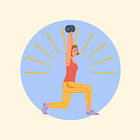There’s nobody more evangelical than the recently converted, right? That’s me, the walking cliche! But I don’t care, and I’ll tell you why - because if you’re not lifting weights, you’re going to regret it.
I grew up in an old people’s home (true story!). From when I was around 7 to when I left for university, home was a retirement home and all my neighbours were older adults. That was a couple of decade ago now, and I’m a couple of decades closer to being eligible to move back in as a resident. But the idea of what it is to be an older adult has changed a lot.
When I see women at races in their 60s, 70s or beyond, I want to be like them. I want to still be running for decades to come. I want to be able to lift things, carry my shopping, get up off the ground and be independent for as long as possible. And the key to that is training for it now.
The reality check
Strength isn’t something we can take for granted. From around the age of 30, we naturally start to lose muscle mass, and if we don’t do anything about it, that decline can speed up as the years go on. It’s called sarcopenia, but all you really need to know is this: use it or lose it.
This isn’t about training your glutes to look great in leggings that give you a wedgie, it is about building and maintaining the muscle that will helps you stay steady on your feet, get up off the ground, carry your shopping and protect your joints when you run. The kind of strength that keeps you living independently, doing the things you love, and avoiding injury.
It doesn’t happen by accident. And sadly, running alone won’t do the job. If you want to stay strong for the miles and the years ahead, you have to work at it. The good news? It doesn’t take as much time as you might think, but it does take consistency.
Strength training for perimenopausal women
If you’re in your 40s or 50s, strength training isn’t just a nice-to-have, or something you’re doing for your future self - it’s one of the best tools you’ve got for looking after your body through perimenopause and beyond.
As hormone levels shift, we become more prone to losing muscle and bone density. That can leave us at greater risk of osteoporosis and frailty later in life. But lifting weights helps protect against that. It signals to your body to hold on to muscle, build strength, and keep bones resilient.
Beyond the physical, strength training can boost mood, improve sleep, and help manage weight at a time when our bodies are changing in ways that can feel frustrating.
What counts as strength training?
Strength training doesn’t have to mean spending hours in a gym surrounded by machines and heavy weights (unless you want it to!). At its simplest, strength training is anything that challenges your muscles to work harder than they do in everyday life, and that could be with weights, resistance bands or just your bodyweight.
What really matters is that you’re working your muscles hard enough that the last few reps feel challenging, because that’s when change happens. And that you’re doing it regularly (aim for twice a week as a starting point).
It’s easy to take for granted that if we fell over and broke a bone, we’d get up, go to hospital and (other than a few months off running) we’d be back to normal after too long. But when I lived in the retirement home, I was all too aware than a fall and a broken bone could see one of our residents going into hospital and not returning. That’s pretty good motivation when you don’t want to do your press-ups.
Make the change
It’s Monday - the start of a new week. Put in your diary, two times this week when you can fit in a few strength moves. Even if you only have 10 minutes spare, it still counts, and you’ll be starting a habit that can grow.
Shorten a run by 10 minutes and finish up with some squats, lunges and press ups if that helps free up some time. It will benefit you more than that last mile will. Oh yes, and eat some protein.
If you’re yet to commit to regular strength training, what barriers are stopping you? And what would help?









I normally do two classes in the gym every week - Power Pump and Body Conditioning. Since starting your faster 5k plan though and committing to two strength sessions a week this is the area I've failed in! Something has always got in the way. Lunchtime work meetings getting in the way of lunchtime classes, or my teachers going away and me not wanting to risk a substitute teacher... But when I've only done one class I've made it count. There is a weight shortage in my gym and I haven't been getting the 3kg dumbbells I want in Body Conditioning. It turns out I can do the class with 4kg dumbbells after all.